Key Takeaways
- Ceilings guide the eye and steer perception — with thoughtful color and texture, the “fifth wall” can visually raise or lower the room, pull accent shades into a cohesive story, and highlight architectural features without sacrificing floor or wall space. Done well, it earns applause every time guests glance upward.
- Thorough planning beats a gallon of touch-up paint — accurate measurements, light evaluations throughout the day, and a well-sketched layout prevent jagged lines, pattern drift, and wasted supplies. A solid plan also protects shoulder muscles and sanity when you’re perched on a ladder for hours.
- Color commitments drive atmosphere — saturated tones add drama and intimacy, while airy tints stretch boundaries and brighten shadows. Decide up front whether you want cozy, energetic, or expansive vibes, then let that single goal dictate every trim, fixture, and fabric choice below.
- Patterns, stripes, and textures succeed when echoed elsewhere — repeat a ceiling’s hue in lamp shades or border tape; mirror its geometry in throw-pillow embroidery; or extend a limewashed finish down a chimney breast. Strategic repetition turns an overhead statement into a full-room symphony.
- Right-sized tools protect finish and necks — quality angled brushes cut crisp edges, microfiber rollers lay even coats, and an adjustable extension pole limits ladder trips. Pair those essentials with a stain-blocking, tinted primer to slash coat counts and banish roller marks for good.
Introduction
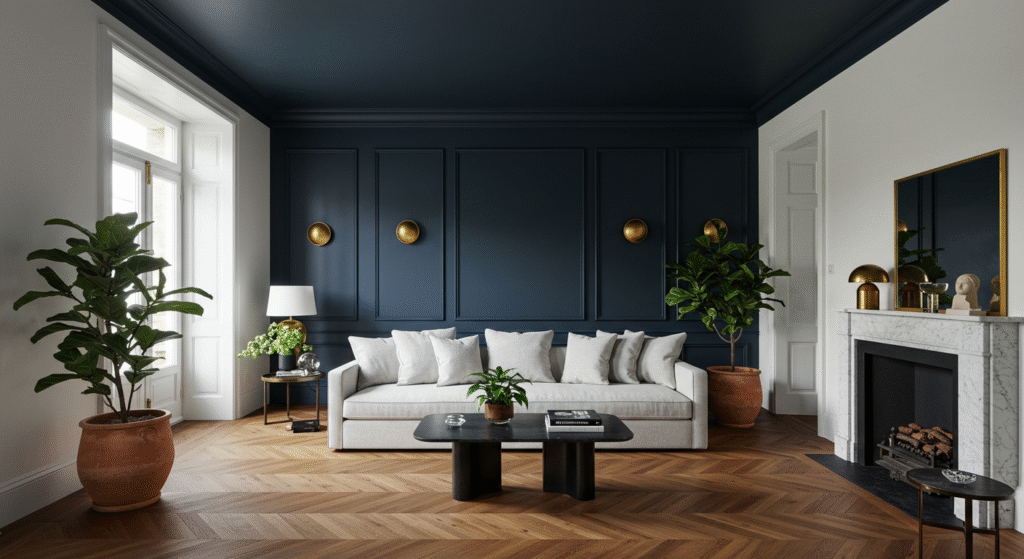
When was the last time you looked straight up in your living room and felt anything other than indifference? Most homeowners lavish attention on wainscoting, feature walls, and gallery shelves, but the wide, bare swath overhead stays a blank afterthought—an unused canvas hungry for creativity.
Yet that “fifth wall” wields quiet power: it can visually expand cramped cottages, inject bold personality into bland rentals, and carve intimate nooks out of soaring lofts.
In this expanded guide, we’ll walk through every practical step you need—from lighting audits to brush angle tricks—to turn ceilings from ignorable planes into headline features.
Along the way, you’ll learn how to choose colors that sync with flooring grain, how to stencil hexagons without migraine-inducing math, and how to keep humid bathrooms from peeling three months after your triumph.
By the end, you’ll be equipped not just to paint overhead surfaces, but to elevate an entire room’s mood with one decisive stroke of color.
Preparing Your Canvas

Measuring and Mapping
A flawless ceiling starts with a ground-level blueprint. Break out a laser distance measurer and jot every dimension, vent cut-out, and light fixture on graph paper. Measure twice: once from wall to wall and again diagonally to catch any sneaky out-of-square corners. Flag joist directions so you’ll know where anchors hide if you plan to install medallions or faux beams later. When considering stripes or geometric layouts, translate those numbers into scaled drawings—this saves you from free-hand guesswork when your arms grow shaky four feet above your head. Mapping now means fewer “Oops” moments later.
Cleaning and Patching
Dust might feel insignificant, but a thin film can sabotage adhesion. Vacuum cobwebs with a soft-bristle brush attachment, then glide a barely damp microfiber cloth across the surface to lift drywall powder left from the builder. Identify every crack, nail pop, or tape seam that telegraphs through old paint; fill with lightweight spackle, feathering edges outward with a six-inch taping knife. After the filler dries fully, sand flush using 220-grit paper on a swivel pole so your primer has the smoothest stage possible. Proper prep can add half a day up front, yet spares you years of staring at a dimpled horizon line.
Priming for Success
Think of primer as insurance and color booster rolled into one. Choose a high-hide, stain-blocking formula and ask the clerk to tint it toward your final shade—one notch lighter for brights, one darker for deep hues. Tinted primer cuts top-coat needs, masks water rings, and locks in ceiling-pen’s dreaded yellowing tannins. Use a W pattern with your roller, pressing lightly to avoid ridges that catch evening light. Let primer cure per label—usually two hours—then inspect from several angles with a work lamp. Any dull patches reveal thirsty drywall needing a second pass before color fun begins.
Choosing the Right Color Family
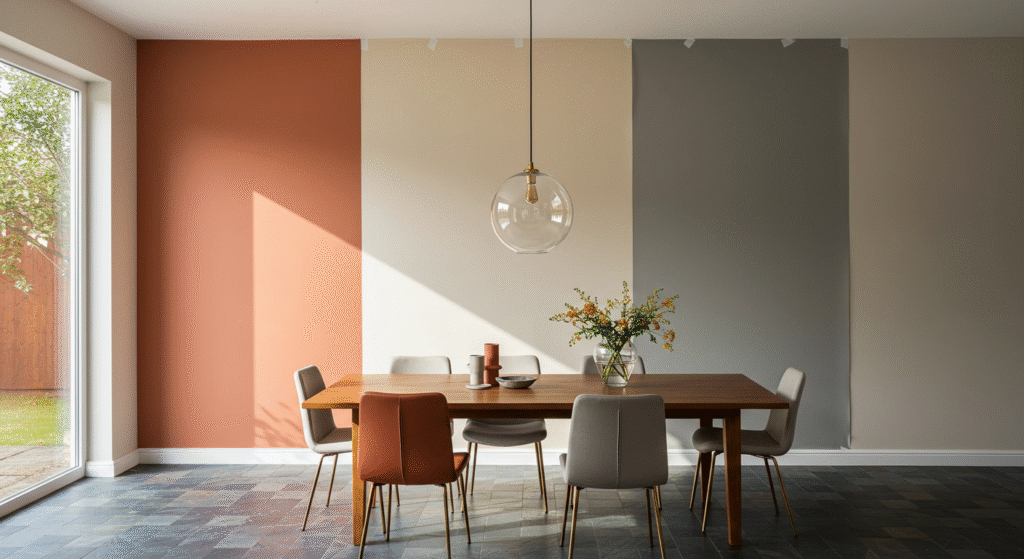
Warm Versus Cool Families
Color temperature sets the emotional thermostat of a room. Warm ceilings—imagine toasted terracotta, burnished copper, or buttered caramel—hug a reading nook in cozy embrace, making winter nights feel shorter. Cool ceilings—icy aqua, misty gray, or glacier white—instill calm in high-traffic kitchens where stainless steel and tile rule. To decide, list the activities beneath that ceiling: conversation, cooking, homework, meditation. Then match a temperature that complements the desired energy. Remember: ceiling tones spill onto walls via reflected light, so a warm top can subtly golden white walls, while cool overhead shades can mute saturated wallpaper.
Harmonizing With Existing Elements
Before buying paint, walk the space and gather color cues already baked into flooring, drapery, area rugs, and upholstery. Walnut tables carry red undertones, slate tiles skew blue-gray, and vintage kilims pulse with deep rust. Align your ceiling pick with those undertones—this cohesion eliminates the jarring “why doesn’t this feel right?” sensation visitors can’t quite name. Use fan-deck chips and place them flat on the floor, then hold others at a 90-degree angle to mimic true ceiling orientation. If you see odd clashes, tweak toward a bridge shade until everything sings in harmony.
Sampling Under Real Light
Daylight morphs across morning golden hues, noon’s cool intensity, and dusk’s dusky rose. Artificial bulbs add their own tint, from warm incandescents to cool LEDs. To survive those shifts, paint 12-inch squares on poster board, label them, and tape overhead in at least four spots. Live with them for two full days, snapping photos every few hours. Note how Color A flatters your sofa at dawn yet looks muddy under night lamps; that data will steer you toward a winner you won’t regret.
Bold Solids for Instant Drama
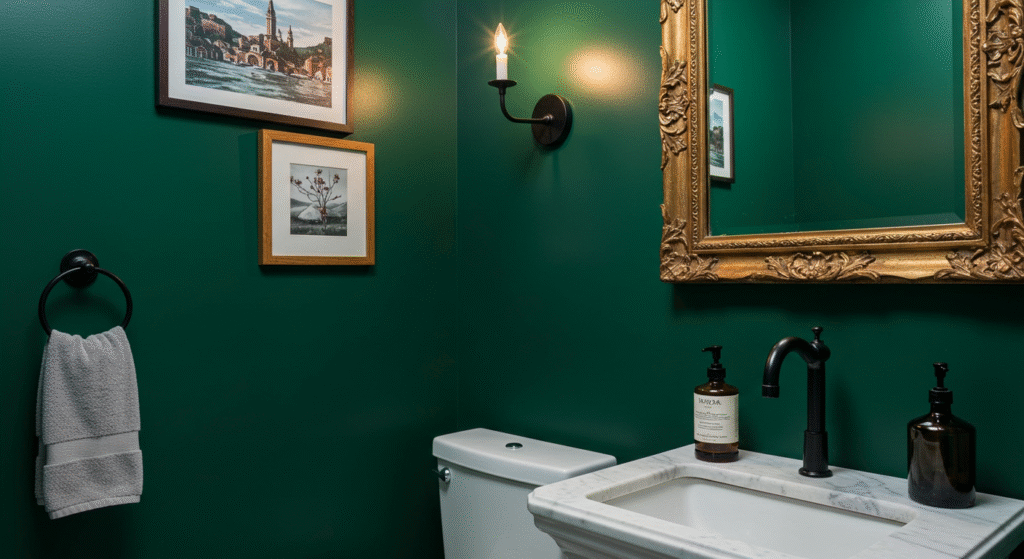
Jewel Tones
Emerald, sapphire, and ruby ceilings drip luxury into tiny spaces like powder rooms or foyers. Their deep saturation swallows shadow lines, creating an intimate jewel-box feeling. Choose a high-quality semi-gloss enamel: its gentle reflectivity amplifies depth and resists moisture from steamy showers. Offset luxurious depth with crisp white trim for punctuation, or embrace maximalism by repeating gemstone hues in towels, art frames, and cabinet pulls.
Deep Charcoals
Graphite shades lend architectural weight, especially in expansive open-plan lofts where white ceilings float too high to feel grounded. Charcoal visually lowers the ceiling plane, creating a sense of embrace. Match with low-sheen paint to dodge distracting glare from industrial pendants. Temper the mood by adding warm metallic accents—aged brass sconces or copper ductwork—that bounce light back into darker corners.
Matte Black Magic
Black up top scares many first-time renovators, yet controlled use yields stunning payoffs. Start in a hallway, closet, or short entry vestibule: small footprints mean minimal paint costs and quick results. Flat black absorbs reflection, hides HVAC runs, and frames modern art like a gallery soffit. Pair with minimalist LED track lights and white walls for high contrast drama worthy of boutique hotels.
Subtle Neutrals That Stretch Space

Off-White Variations
Classic ceiling white often reads stark, almost clinical. Upgrade to nuanced neutrals—think ivory, antique lace, or pale oatmeal—to retain brightness while softening edges. These tones bounce daylight deeper into living rooms yet avoid the “builder basic” vibe. If you’ve installed reclaimed beams, off-whites amplify their warmth without stealing the spotlight.
Pale Pastels
Whispers of peach, mint, or robin’s-egg blue lift low ceilings by reflecting more light than saturated cousins. Pastels also pair beautifully with darker accent walls, preventing a cave-like feel. For best results, choose a pastel two shades lighter than the dominant wall color; the subtle shift maintains harmony without looking matchy-matchy.
Greige Grace
Greige—neither pure gray nor beige—acts like design Teflon, refusing to clash with anything. It calms busy open-concept layouts that juggle multiple seating areas. Select a greige with an undertone that mirrors your flooring grain—cooler for ash-stained planks, warmer for honey oak. Layer in natural textures—linen blinds, jute rugs—to let the ceiling’s neutrality anchor the organic palette.
Two-Tone Techniques
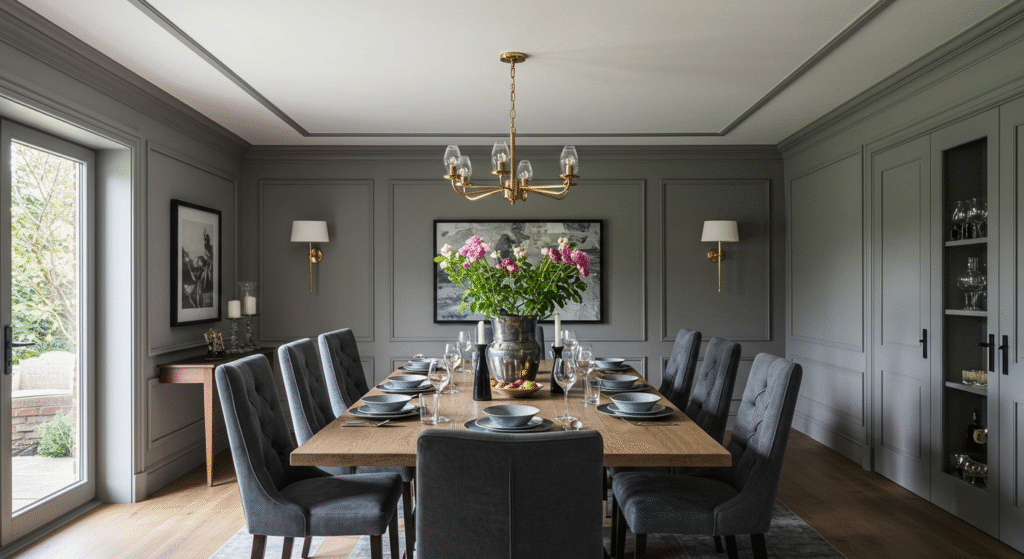
Picture-Frame Borders
For vintage elegance minus ornate plaster, roll the ceiling center in a dominant shade, then brush a six-inch perimeter in a contrasting hue. The border drips subtle sophistication and can visually replicate old tin tiles when you apply metallic glaze. Use a laser level to mark crisp lines; filling between painter’s tape gives results sharp enough to fool house guests into thinking you hired pros.
Soft Gradient Fades
Ombre ceilings mimic dawn clouds or ocean depths. Pick two tints: one near the wall line, another for the center. Roll the lighter shade first, then dampen a wide brush and feather where the deeper color begins. The blurred band hides minor lap lines and adds movement overhead—a fantastic trick for bedrooms craving calm.
Accent Band Strips
Paint a bold eight-inch stripe circling the room one foot away from crown molding. This horizontal band guides sight upward, echoing the look of custom millwork without carpentry. Choose a hue drawn from artwork or a beloved area rug to forge connection. In retail settings, brand colors used here subtly reinforce identity without overwhelming products on display.
Geometric Patterns

Checkerboard Ceilings
Oversized checkerboards inject whimsy into nurseries or craft rooms. Alternate two muted pastels for a soft patchwork effect. To lay out, snap chalk lines in both directions, then mark every other square with painter’s tape. Roll color A, peel tape, let dry, re-tape, and roll color B. Satin sheen hides brush overlap better than flat in multi-coat designs.
Triangular Motifs
Bold triangles radiate energy in reading alcoves or home offices. Anchor the apex of the largest triangle above your favorite chair to create an invisible canopy. Outline shapes with low-tack tape and fill using a dense foam roller for sharp edges. Finish by repeating triangle colors in throw pillows or framed prints to unify the space.
Honeycomb Hexagons
Hexagons evoke modern chemistry labs or vintage bee hives—your choice depends on color and scale. Cut a reusable stencil from flexible Mylar; trace overlapping honeycombs across the ceiling, skipping a few cells for breathing room. Alternate matte and metallic paints to catch ambient light, then seal with a clear non-yellowing top coat for scrub resistance.
Stripes and Lines
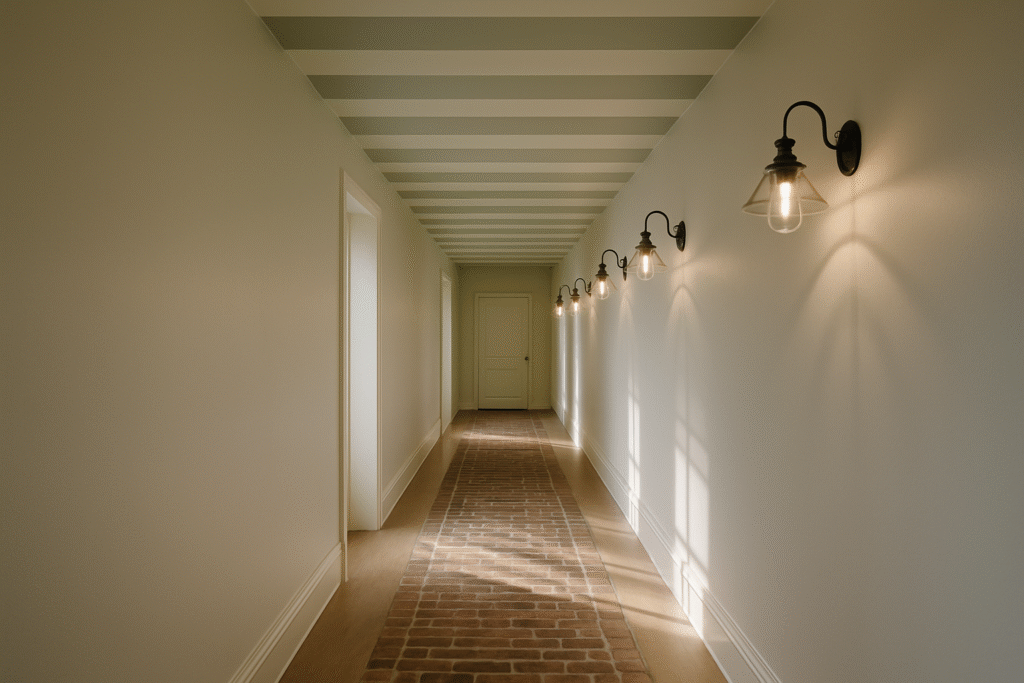
Classic Parallel Stripes
Horizontal stripes roughly six inches wide can widen narrow dining rooms, while vertical stripes elongate corridors. Use a level and frog tape to maintain uniform widths. Roll the lighter tone first, let cure, then overlay darker bands. Crisp stripes pair beautifully with shaker cabinets and mid-century furnishings.
Chevron Arrows
Chevrons inject motion, steering eyes toward architectural focal points like fireplaces or arched windows. Determine arrow angle with a protractor, snap chalk lines, and tape carefully—misaligned chevrons stand out from across the room. Paint alternating color tips for lively rhythm, echoing chevron pillows below.
Pinstripe Details
Even tiny one-inch metallic pinstripes can propel a ceiling into couture territory. Lay them between wider matte bands for subtle shimmer that only appears when lamps switch on. Use metallic craft paint and an artist’s liner brush; slight hand-drawn wobble reads handcrafted rather than flawed.
Textures and Faux Finishes
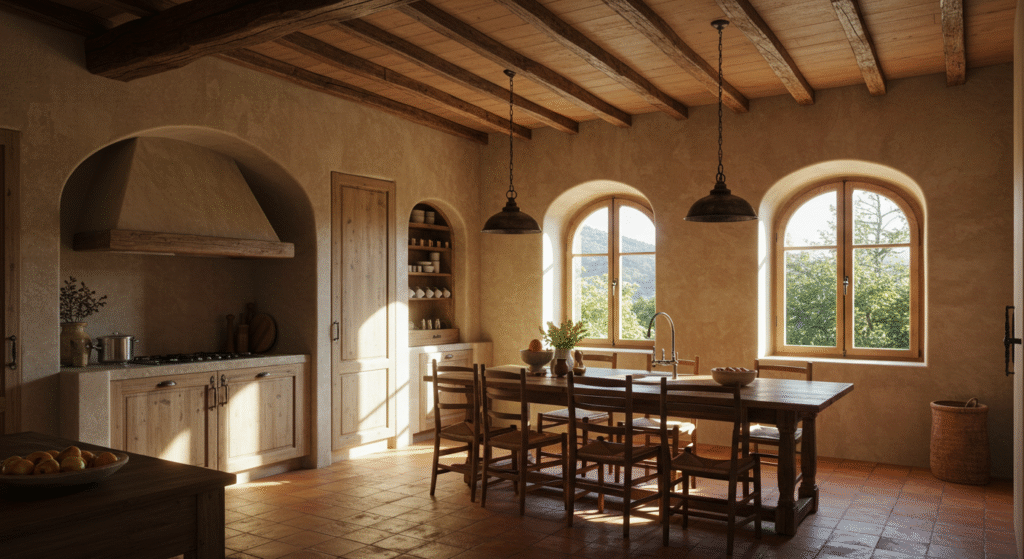
Limewash Softness
Limewash—crushed limestone infused with pigment—creates matte, velvety movement that breathes through microcracks. Apply with a block brush using X strokes so the base coat peeks through randomly. Over plaster or adobe walls, limewash ceilings render old-world harmony suitable for Mediterranean kitchens or Tuscan sunrooms.
Suede Rollers
Specialty rollers stamped with micro-slits drag paint in micro-striae that resemble brushed suede. Choose earth tones like warm taupe or clay to emphasize tactile softness. When overhead spotlights graze this finish, faint shadows add dimensional intrigue without heavy ornamentation.
Plaster Trowel Swirls
For French country charm, skim a thin layer of joint compound, then swirl a broad drywall knife in overlapping arcs. Once cured, prime with a penetrating sealer and paint with matte acrylic. The raised relief hides drywall join lines while bouncing subtle highlights across evening candlelight.
Metallic and Pearl Effects
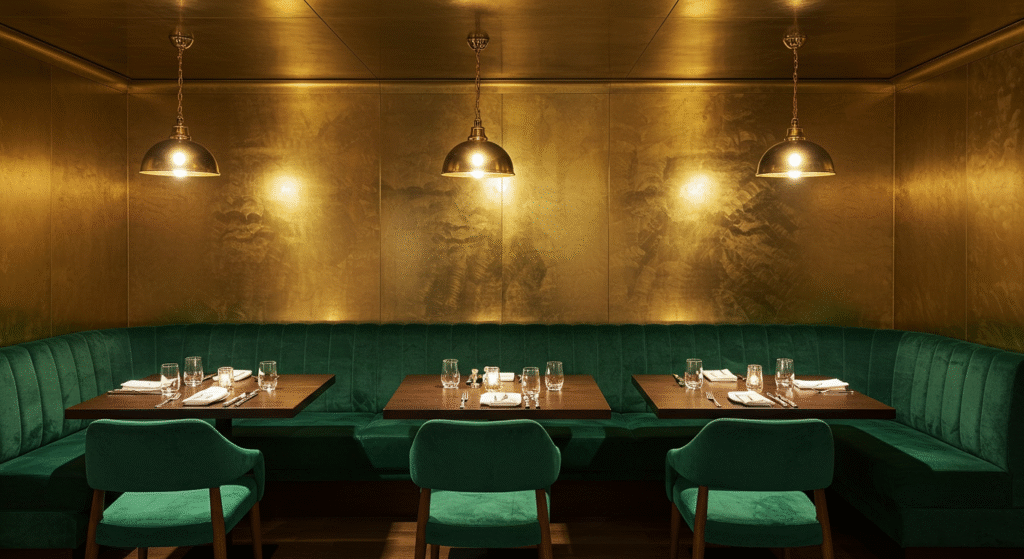
Brushed Gold Sheen
A brushed gold ceiling gilds dinner parties in warm luster. Two thin coats of metallic latex, cross-hatched with a wide soft brush, mimic beaten metal plates. Dimmable sconces reflecting off gold amplify ambiance without flashy glare—a trick used in luxury hotel lounges worldwide.
Silver Leaf Accents
Silver leafing kits allow true metal film—far brighter than metallic paint. Apply adhesive size in medallion recesses or fleur-de-lis stencils, lay fragile sheets, then burnish with a cotton cloth. Seal with non-yellowing varnish to guard against tarnish. Paired with cool wall grays, silver lifts a contemporary office to gallery sophistication.
Pearlescent Layers
Pearl additive stirred into acrylic paint scatters light across microscopic mica flakes. Roll evenly to avoid lap shadows; two coats suffice for whisper shimmer ideal in bedrooms, nurseries, or spa bathrooms. When sunrise sneaks through blinds, pearlescent ceilings glow like morning dew.
Mural Miniatures
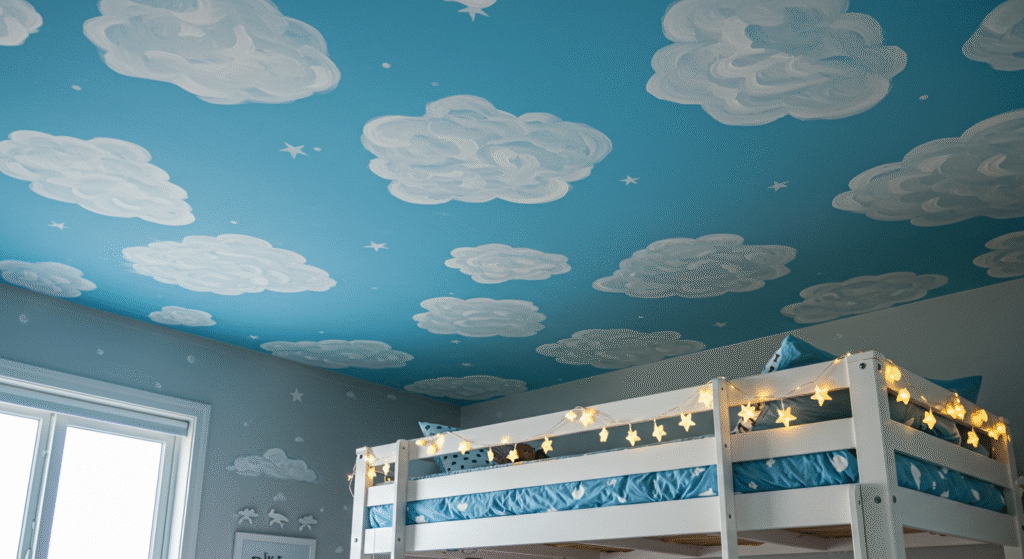
Sky and Cloud Illusions
Transform children’s rooms into limitless skies by rolling a gradient from cobalt at crown molding to pale cerulean at center. Dab cloud shapes with a natural sea sponge loaded with white paint, then soften edges with a dry stipple brush. Night-time LED stars adhered later complete a dreamy escape.
Botanical Corners
Paint climbing ivy or flowering wisteria starting at ceiling corners, trailing toward a central pendant. Outline vines with a fine liner, fill leaves in two greens for depth, and add blossoms matching bed linens to ensure cohesion. Botanical corners break ceiling monotony while leaving room center serene.
City Silhouette Edges
Urban loft? Stencil a skyline border—Brooklyn Bridge cables, Tokyo towers—around room perimeter at ceiling edge. Keep silhouettes one shade darker than ceiling background for low-contrast subtlety that still charms sharp eyes. Track lighting angled upward dramatizes jagged rooflines.
Ceiling Medallions and Borders
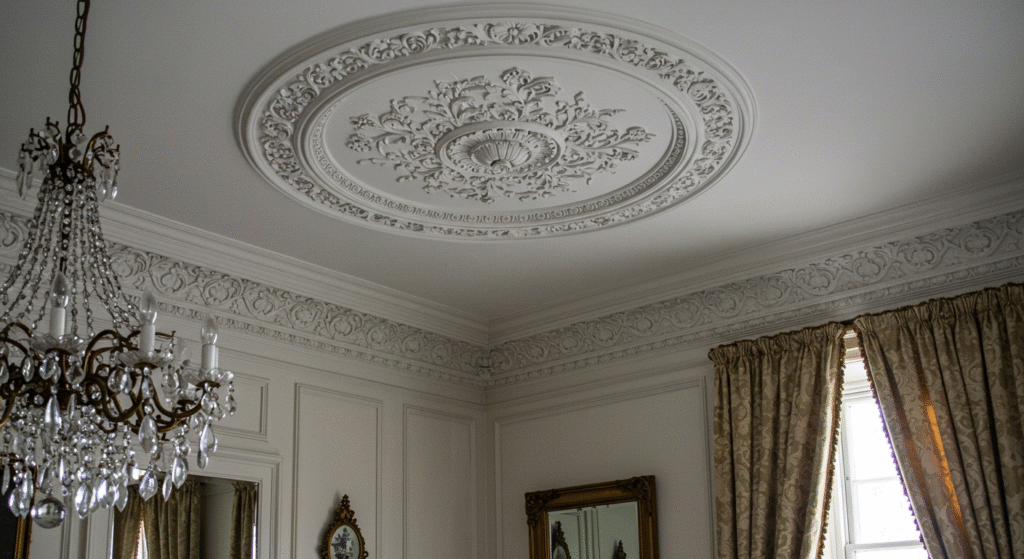
Medallion Makeovers
Lightweight polyurethane medallions arrive primed; spray them matte white or accent colors before mounting to avoid drips on fresh paint. Detail raised scrollwork using artist brushes dipped in metallic wax. When hung around a minimalist pendant, the ornate disk bridges traditional and modern aesthetics effortlessly.
Scroll Borders
Hand-painted scrolls echo European manor ceilings. Use a projector to cast your design overhead, trace with chalk, then paint with a round script brush. Keep border width under two inches to prevent visual clutter. Seal with satin clear coat so dust wipes clean.
Tape-Free Banding
For confident painters, a steady hand and laser guide replace tape. Rest your wrist on a yardstick braced against the wall and glide the brush smoothly for perfect lines. Organic variances convey artisan pride, ideal for rustic cottages or boho lofts.
Lighting Integration
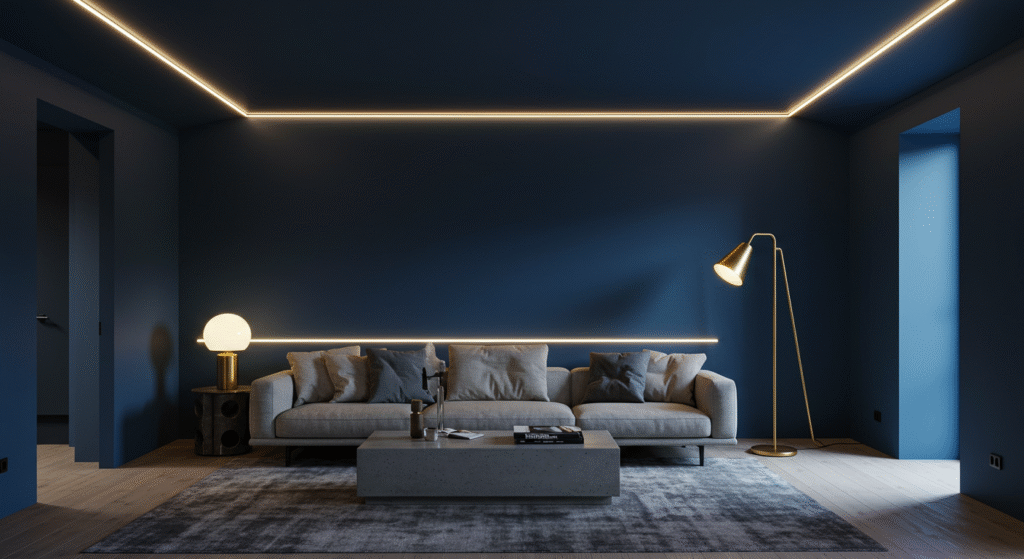
Recessed Light Rings
Roll a two-inch lighter halo around each recessed can’s trim. The subtle contrast makes fixtures look custom and spreads illumination onto adjacent paint, visually enlarging the glowing spot.
Pendant Highlight Zones
Trace a crisp circle or hexagon around pendant mounts in a contrasting tint found in nearby bar stools or countertop veining. The shape acts like a stage light gobo, framing fixtures like modern jewelry and tying them to room palette.
LED Cove Glow
Install LED tape inside crown molding, set to warm white for dinners or cool daylight for chores. Test color with sample boards before final ceiling coat; LEDs can shift perceived hue by up to 10 percent. A dimmer switch controls mood and saves energy.
Maintenance and Touch-Ups

Spot Cleaning Tips
Flat paint hides imperfections yet stains quickly. For pencil marks or cooking splatters, press a damp sponge with mild dish soap for ten seconds, twist gently, and blot dry with microfiber. Avoid circular scrubbing that polishes flat sheen into shiny spots.
Repainting Strategies
When style evolves, lightly sand spray bumps, vacuum dust, and spot prime repaired areas. Roll new color perpendicular to original direction to mask roller tracks. Work in small sections keeping a wet edge; ceiling lap lines glare under slanted lamps.
Humidity Control
High humidity shortens paint life. Keep bathroom exhaust fans running 15 minutes post-shower, seal grout, and consider a dehumidifier if levels exceed 55 percent. A drier ceiling resists mildew and flaking for years.
Budget and Product Guide

Tool Checklist
- Angled sash brush for cutting along crown and fixtures without taping every edge.
- Telescoping roller pole that adjusts from 3 to 8 feet, saving climbs and neck strain.
- Low-nap microfiber roller cover for smooth, lint-free finishes on drywall.
- Reusable drop cloths in heavyweight canvas—cheaper long term than plastic sheeting.
- Laser level and chalk line to map perfect geometry even on slightly warped ceilings.
Paint Grades
| Use Case | Budget Brand | Mid-Tier | Premium |
|---|---|---|---|
| High-traffic kitchen | Contractor flat (e.g., Glidden Pro) | Behr Ultra—grease-resistant eggshell | Benjamin Moore Aura Bath & Spa—mildew-proof satin |
| Bathroom humidity | Valspar Mildew-Resistant Ceiling Paint | HGTV Home by Sherwin-Williams Ceiling | Fine Paints of Europe Eco—ultra-durable matte |
| Accent murals | Craft acrylics mixed with Floetrol | Farrow & Ball Modern Emulsion—rich pigments | Little Greene Intelligent Matt—superior colorfastness |
Cost-Saving Hacks
Time purchases around holiday rebates; many major brands slash gallons by 30 percent. Split specialty rollers among neighbors tackling their own projects. Repurpose leftover sample pots for stencil accenting or furniture touch-ups rather than binning them.
Summary Table
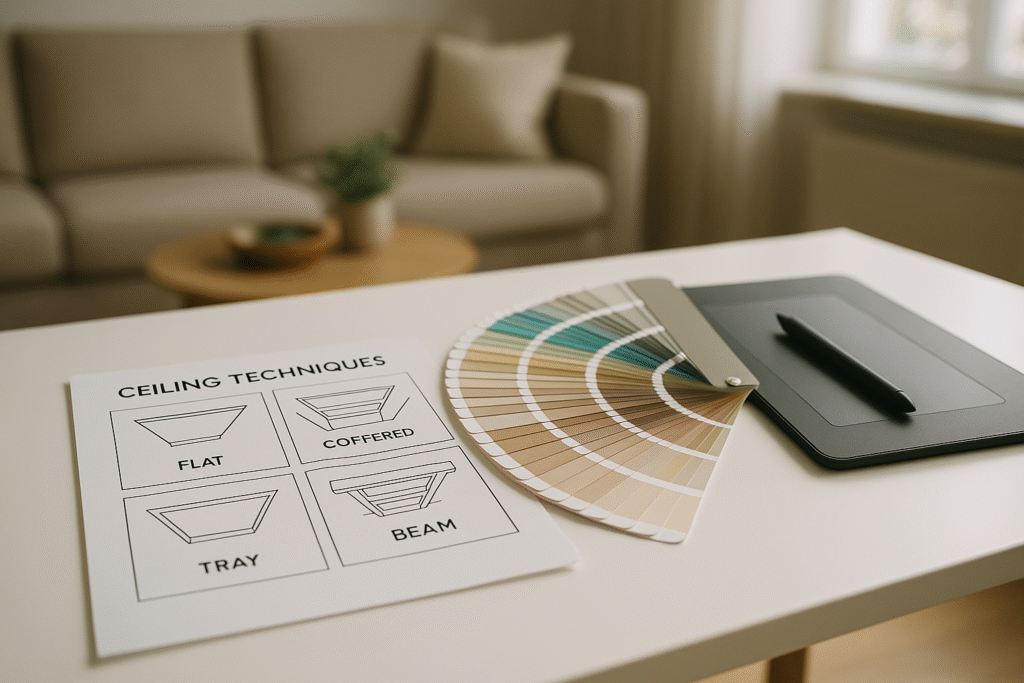
| Section | Core Idea | Quick Tip |
|---|---|---|
| Preparing Your Canvas | Clean, patch, prime thoroughly | Tint primer toward final shade |
| Choosing Colors | Warm vs. cool harmony | Sample throughout day & night |
| Bold Solids | Jewel, charcoal, black drama | Start small to test courage |
| Subtle Neutrals | Off-white, pastel, greige stretch | Lighter than wall for height |
| Two-Tone | Borders, gradients, bands | Laser lines for perfect edges |
| Geometric | Checker, triangle, hexagon | Low-tack tape minimizes peel |
| Stripes | Parallel, chevron, pinstripe | Align with room’s longest wall |
| Textures | Limewash, suede, swirl depth | Practice on scrap drywall first |
| Metallics | Gold, silver, pearl shimmer | Seal metallics to prevent scuffs |
| Murals | Sky, vines, skyline charm | Dry sponge softens cloud edges |
| Medallions | Disk, scroll, free band artistry | Paint medallion before install |
| Lighting | Halos, pendant zones, cove LEDs | Choose bulb temp before paint |
| Maintenance | Clean, repaint, dehumidify | Roller perpendicular on refresh |
| Budget Guide | Tools, brands, money savers | Buy at rebate sales events |
Conclusion
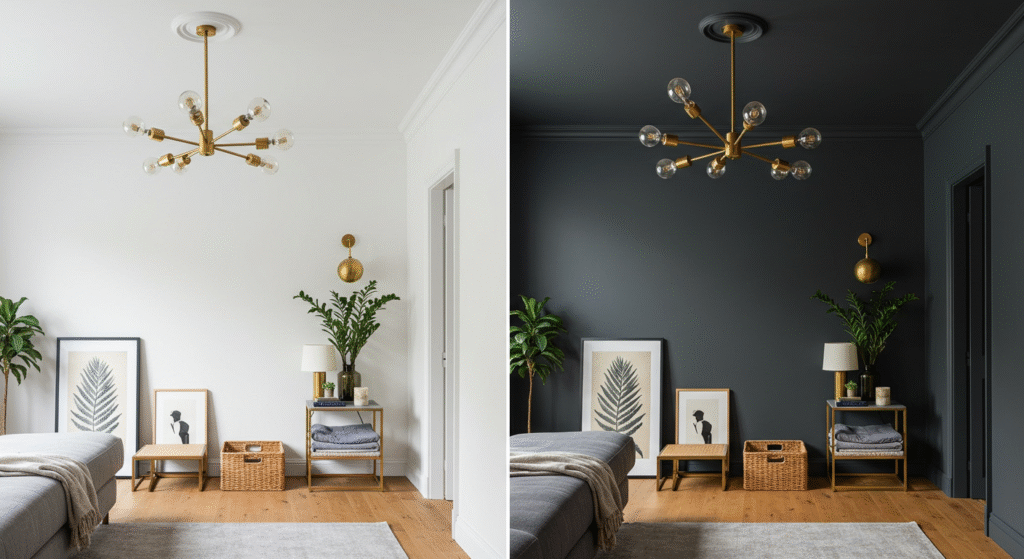
A ceiling seldom commands attention, yet when you invest care, color, and creativity, that lofty plane morphs into the room’s secret star.
By prepping with patience, sampling under every bulb and sunset, and echoing ceiling details through fixtures and fabrics, you weave a narrative that reads from floor to sky.
Whether you lean into sumptuous emeralds, feathery ombrés, or metallic whispers, trust that the fifth wall rewards brave vision. So tape your drop cloths, cue up your playlist, and look upward—the most overlooked real estate in your home is ready for its grand debut.
FAQ
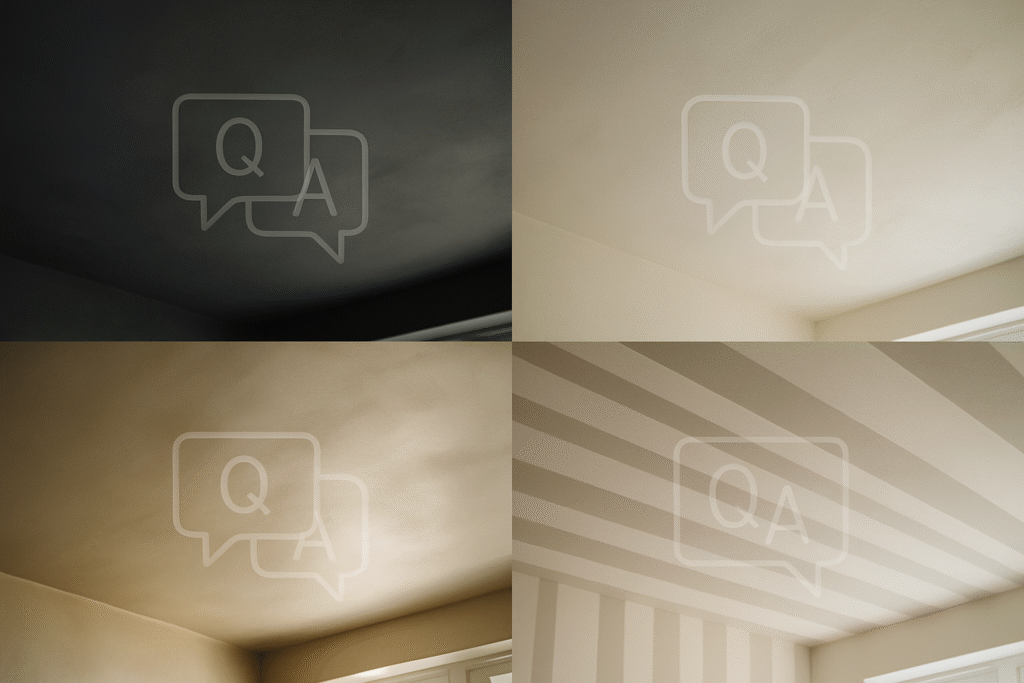
Q — Will a dark ceiling make my room feel smaller?
A — Not necessarily. Dark hues can cozy a cavernous space, grounding lofty ceilings, while paired light walls guard against any cave effect. Test a two-by-two-foot swatch first; the sample will reveal if the color compresses or simply cocoons the room.
Q — What finish is best for ceilings?
A — Flat wins for hiding drywall seams, but eggshell resists stains in kitchens and baths. Matte acrylic offers middle-ground durability without the sheen of satin. Match finish to room function rather than blanket rules.
Q — How do I paint without neck strain?
A — Invest in a high-quality pole and keep strokes slow and steady. Schedule short stretch breaks every 30 minutes; simple shoulder rolls keep muscles loose and reduce next-day soreness.
Q — Can I paint over popcorn texture?
A — Yes, though results vary. Use a thick-nap roller, apply gentle pressure, and prime first to lock loose granules. If texture dates the room, consider professional scraping or a new drywall layer before color.
Q — How long should I wait between coats?
A — Most latex paints require at least two hours, but humidity can extend cure time. Touch an inconspicuous spot; if paint feels cool or tacky, wait longer to avoid peeling later.
Q — Do I need special paint for bathrooms?
A — Mildew-resistant formulas withstand steam better than standard flats. Pair with a powerful exhaust fan to vent humidity and extend lifespan.
Q — What lighting works best with a bold ceiling?
A — Dimmable LEDs allow you to tweak warmth and brightness, revealing color richness without glare. Adjustable track heads let you spotlight art or architectural beams, emphasizing overhead drama.
Q — Is primer optional if the ceiling looks clean?
A — Only on new drywall pre-coated by the builder. Any marks, yellowing, or color changes demand primer for adhesion and color accuracy.
Q — Can I stencil a pattern without professional help?
A — Absolutely. Repositionable spray adhesive keeps stencils flush. Work in small sections, load rollers lightly, and wipe stencil backs often to prevent bleed-through.
Q — How often should I repaint a ceiling?
A — Low-traffic bedrooms may last a decade, while smoky kitchens and humid baths often need a refresh every four to five years. Regular dusting and humidity control stretch those intervals.

Gabrielle J. Smith is the pulsating essence that brings life to the world of fashion and color. With an innate talent for understanding the nuances of hues, she has the uncanny ability to paint narratives with her words, diving deep into the realm of color trends and the art of harmonizing them. Not just an expert in the field, Gabrielle also plays a pivotal role in strengthening the cohesion of our team, ensuring growth and harmony. Each of her articles is a testament to her passion, weaving captivating tales that resonate with readers and fashion aficionados alike.
Reviewed By: Joanna Perez and Anna West
Edited By: Lenny Terra
Fact Checked By: Matthew Mansour
Photos Taken or Curated By: Matthew Mansour
